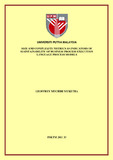| dc.description.abstract | One of the most popular process modeling languages is the Business Process Execution Language (BPEL). Despite the popularity, BPEL process models have an inherent complexity. This complexity keeps on increasing with age as a result of maintenance routines. Structural properties of BPEL process models such as size and complexity are claimed to influence maintainability factor of the process models. In the past, researchers have applied measurement to quantify the size and complexity of process models and thereafter utilized the measurement results to modify or to enhance the quality of the models. The problem with BPEL process measurement is that very few valid metrics exist that can beused for BPEL process models. Although several validation studies have been carried out, these were based on other language environments other than BPEL. To generalize the results of these studies to BPEL process models might be inaccurate, especially that BPEL has richer semantics than most other business process modeling languages. In addition, many of the existing validation studies did not focus on the external quality characteristic of maintainability, which makes it difficult to assess the value of the validated metrics as maintainability indicators for BPEL process models. To address this problem, this thesis proposes a suite of size and complexity metrics for measuring the structural properties of BPEL process models and then investigates whether these metrics can be useful indicators of the maintainability of BPEL process models. Theoretical validation studies based on Briand’s framework and Weyuker’s properties were conducted to find out whether the metrics were theoretically sound as required. Empirical studies by means of experimentations were also conducted to find out whether the metrics had any correlation with maintainability sub-characteristics of understandability and modifiability. Theoretical validation results indicate that the metrics satisfy the two theoretical frameworks at acceptable levels in their respective categories. Experimental results were also significant for all proposed metrics, which means that these metrics are highly correlated to maintainability subcharacteristics of understandability and modifiability. This shows that the proposed size and complexity metrics can be useful as indicators of the maintainability of BPEL process models. | en_US |

